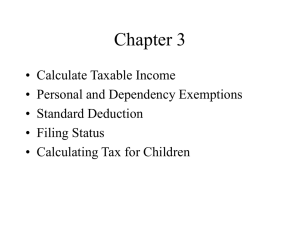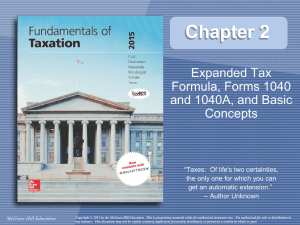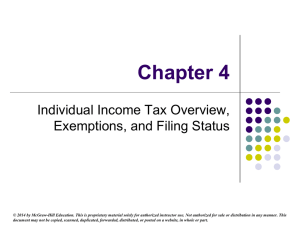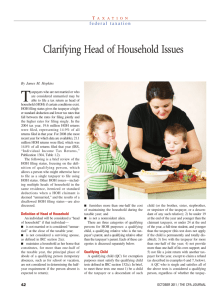Basic VITA Training
advertisement
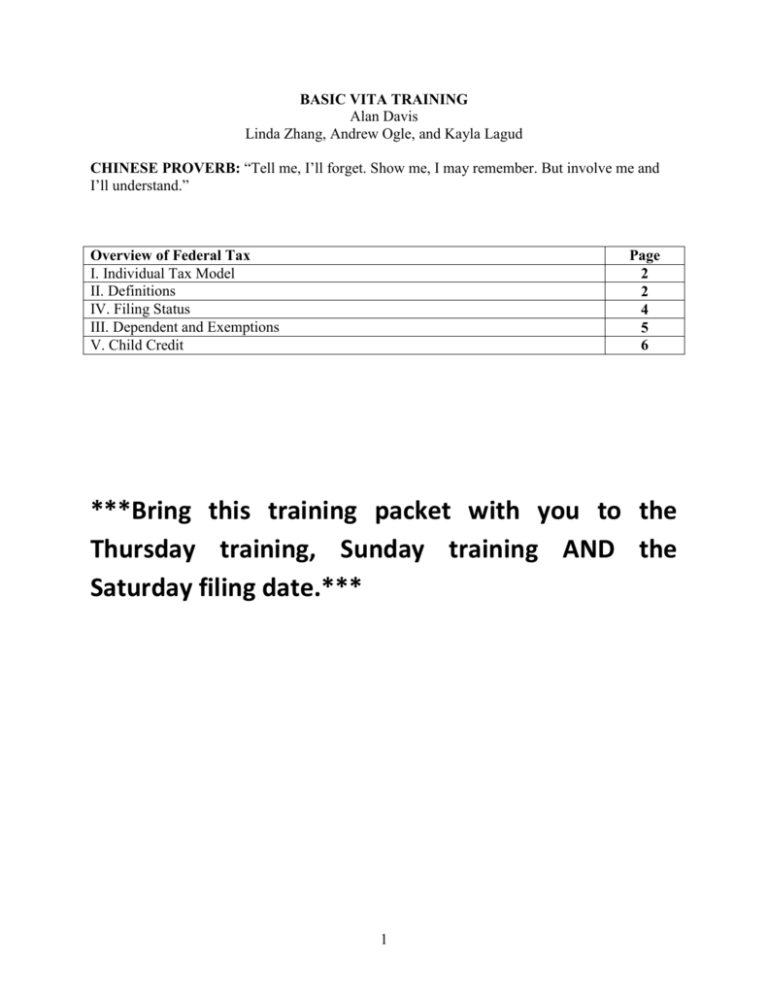
BASIC VITA TRAINING Alan Davis Linda Zhang, Andrew Ogle, and Kayla Lagud CHINESE PROVERB: “Tell me, I’ll forget. Show me, I may remember. But involve me and I’ll understand.” Overview of Federal Tax I. Individual Tax Model II. Definitions IV. Filing Status III. Dependent and Exemptions V. Child Credit Page 2 2 4 5 6 ***Bring this training packet with you to the Thursday training, Sunday training AND the Saturday filing date.*** 1 OVERVIEW OF FEDERAL TAXATION I. INDIVIDUAL TAX MODEL: Income Broadly Conceived – Exclusions Gross Income (All Income Subject To Tax) –Deductions “For” AGI =Adjusted Gross Income (AGI) –Greater Of: Standard Deduction OR Itemized Deductions –Personal and Dependent Exemptions ($3,950 for self, spouse, and each dependent) = Taxable Income X tax rate =Gross Tax Liability –Non-refundable credits –Prepayments - withholdings from wages –Refundable credits =Tax refund (or additional tax due) II. DEFINITIONS: Income Broadly Conceived – Income is defined as some event that increases net worth. Common examples include salary income, self-employment income, interest income, dividend income, capital gain, etc. Exclusion – Some items of income are not subject to tax. Common examples are municipal bond interest, gifts, and inheritances. Deduction – A deduction is an expense allowed to reduce taxable income. There are two types of deductions: Deductions for Adjusted Gross Income (AGI) –the following are the most common a. Net capital loss (limited to $3,000) b. IRA (Individual Retirement Account) contributions c. Expenses related to self-employment d. Moving expenses e. Interest on student loans f. Alimony g. Expenses related to rental income 2 Standard Deduction – The amount of the standard deduction depends on filing status1. Taxwise will handle all of this for you. Filing Status 2014 Standard Deduction Single $6,200 Married Filing Separate $6,200 Married Filing Joint $12,400 Head of Household $9,100 Itemized deductions – Note that the taxpayer can only itemize their deductions if the total is greater than the taxpayer’s standard deduction. The following are the most common a. b. c. d. e. f. Medical expenses (only the portion >10% of AGI is deductible) State income taxes Property taxes Charitable contributions Casualty and theft losses (only the portion >10% of AGI is deductible) Home mortgage interest Credit – A sum removed from the gross tax liability granted by the government for various reasons to provide tax relief. While a deduction reduces taxable income, a credit reduces tax liability directly. For example, if the taxpayer is in a 30% tax bracket, a $1,000 deduction will reduce her tax by $300 (30% of $1,000) while a $1,000 credit will reduce her tax liability by $1,000. EXAMPLE 1: Ron Swanson’s filling status is single with no dependents. In 2014, he had salary income of $70,000 and municipal bond interest income of $200. He made a $500 contribution to IRA, paid property taxes of $ 1,000, made a charitable contribution of $ 800, and paid state income tax of $8,000. 1. What is his taxable income for the year 2014? 2. Suppose state income tax paid is $1,000, what’s his taxable income for 2014? 1 There is an additional amount added to the standard deduction if the taxpayer is over age 65 and/or blind. TaxWise knows this and will calculate it automatically so you don’t have to. 3 III. FILING STATUS (see Part IV for the definitions of exemption and the terms in italic): Taxpayers fall into one of the following categories (which are arranged from most attractive to least attractive). Married-Joint – Generally, taxpayers who are married at the end of the year are entitled to this status. In the case of death, there are the following special rules: The taxpayer qualifies as married joint in the year of spouse’s death (and receives 2 personal exemptions) IF the surviving spouse maintains a dependent child, she qualifies for married joint for two additional years (without an exemption for the deceased) Head of household – In general, to claim this filing status, a taxpayer must: 1. Be unmarried 2. Paid for more than half the cost of keeping up the home for the year 3. Have a “qualifying person” who is a qualified child OR qualified relative that meets relationship test (see page 5) live with her in her home for more than half of the year Abandoned spouse rule: A taxpayer may use the head of household rates, even if she is married, if she meets all of the following conditions: 1. She must pay at least half of the cost of maintaining her home. 2. Her spouse did not live in the household for the last six months of the year. 3. The home was the principal residence of the taxpayer’s child for more than half the year 4. The taxpayer could claim the child as a dependent Single – Unmarried taxpayers who do not qualify for head of household status. Married–Separate – Married taxpayers who choose to file separately (seldom beneficial). EXAMPLE 2: Megan and Keith are married with one child from Keith’s previous marriage. In August 2013, Keith went to get a beer and never returned. The child continues to live in Megan’s home. Keith did not return for the whole year of 2013. 1. What is Megan’s filling status for 2013? 2. What is Megan’s filling status for 2014? 4 IV. PERSONAL EXEMPTIONS AND DEPENDENTS: In 2013, a taxpayer gets an exemption of $3,900 for herself, her spouse and each of her dependents. Note that if the person may be claimed as a dependent by someone else (such as a parent), the taxpayer does not get the exemption for herself. See the rules below to determine if someone is a dependent. Rules for Claiming an Exemption for a Dependent In order to be a dependent, the person must: Not file a joint return with her spouse (unless filed only to receive a refund). Be a US citizen, US resident, resident of Mexico, OR resident of Canada. (Note: The citizenship/residency test is waived for a “qualifying child” who is adopted as long as she lives with a US person.) Be either a “qualifying child” or “qualifying relative” Tests To Be a Qualifying Child Tests To Be a Qualifying Relative 1. The child must be your son, daughter, stepchild, eligible foster child, brother, sister, half brother, half sister, stepbrother, stepsister, or a descendant of any of them. 2. The child must be (a) under age 19 at the end of the year, (b) under age 24 at the end of the year and a full-time student, or (c) any age if permanently and totally disabled. 3. The child must be younger than the taxpayer unless permanently and totally disabled 4. The child must have lived with you for more than half of the year.2 5. The child must not have provided more than half of his or her own support for the year. 2 1. Cannot be “qualifying child” of any other taxpayer 2. The person must be either (a) a member of the household (live with the taxpayer for entire year), or (b) a relative (relationship test). Relative is defined as parents, children, grandchildren, grandparents, sisters/brothers, uncles/aunts, nieces/nephews and in-laws. (Notes: Inlaws from a divorced marriage still are considered “qualifying relatives.” Cousins are not considered “relatives”; however a cousin who lives with the taxpayer could be a “qualifying relative”.) 3. The person's gross income for the year must be less than $3,950. 4. The taxpayer must provide more than half of the person's total support for the year. College students are considered to live with their parents. 5 EXAMPLE 3: John and Jane are married with a 3 year old son. At 11:59 pm on December 31, 2014, Jane gives birth to a daughter. How many exemptions do they get? V. CHILD CREDIT In addition to the exemption, the taxpayer may take a credit of $1,000 for each child that meets the following tests: 1. 2. 3. 4. 5. The taxpayer’s qualifying child The child is under age 17 at the end of 2014. The child is a citizen or resident of the US. The child lived with you for more than half of 2014. The child did not provide more than half of his/her own support. EXAMPLE 4: Determine if the following individuals are dependents (assume that the support test is met for all of them and that they all are US citizens). Also, indicate if they qualify for the child’s credit. 1. Uncle John who has income from City of St. Louis bonds of $100,000. There is a particular provision in the Internal Revenue Code which exempts this income. 2. Uncle Bob who has income from renting an apartment of $4,000 and rental expenses of $2,000. 3. Cousin Julie who lives with the taxpayer and has no income. 4. Peter, the taxpayer’s son, who is 20, a full-time student and has gross income of $5,000. 5. Same as 4, except Peter is 25. 6 6. Katie, the taxpayer’s granddaughter, who is 12 and has no income and lives with the taxpayer. 7. Allison, the taxpayer’s child, who is 25 and has no income. EXAMPLE 5: Determine Judy’s filing status and # of exemptions for each of the following years: 2012—She is married to Jeff and has a 5 year old child 2013—Jeff dies in April 2013; she continues to maintain the support for the child 2014—She continues to provide support for her child 2015—She continues to provide support for her child 2016—She continues to provide support for her child 7 Special Rules for Claiming an Exemption for a Dependent: In cases of divorce, the custodial parent is allowed the exemption for the child unless the custodial parent agrees to allocate the exemption to the non-custodial parent. The noncustodial parent also gets the rights to the child tax credit described above. EXAMPLE 6: Adam and Whitney are married. They have one child, Ellie, who is 7 years old. In 2013, they get a divorce. The divorce papers are silent as to who gets to claim Ellie as a dependent. a. Whitney is Ellie’s custodian. Who gets to decide who claims Ellie as a dependent? b. Let’s suppose Whitney claims Ellie. What is her filing status and how many exemptions does she get? c. Whitney signed papers saying that Adam can claim Ellie as a dependent. Whitney still is Ellie’s custodian. What’s Adam’s filing status and how many exemptions does he get? 8

